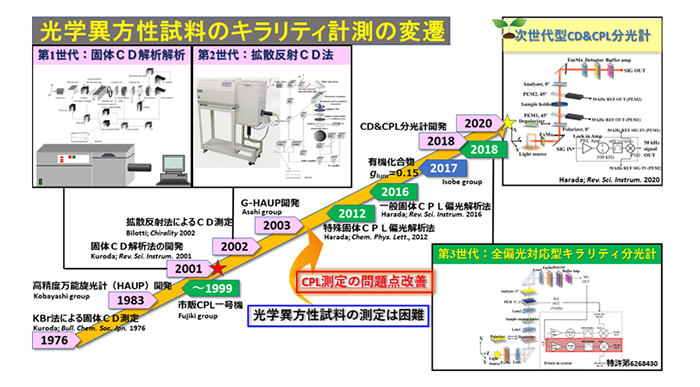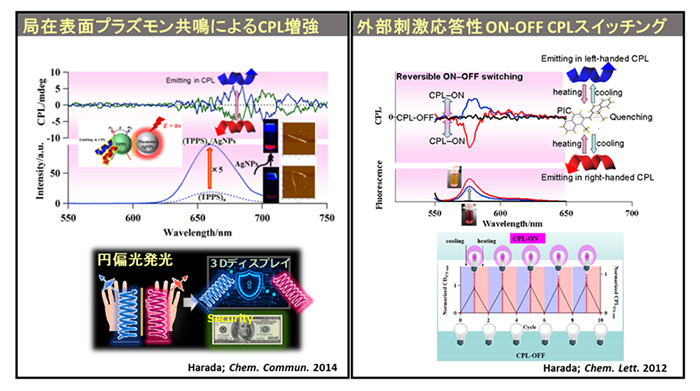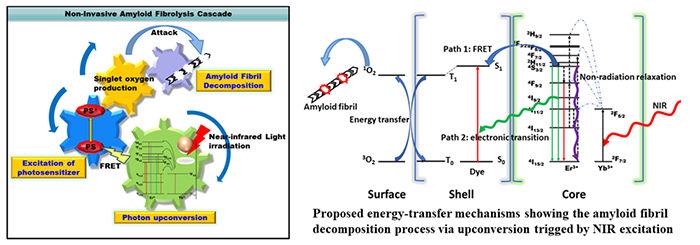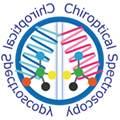Harada Group
Research Topic 1
Chiroptical Spectrophotometer: Development and Application
Circular dichroism (CD)/circular birefringence (CB) and circularly polarized fluorescence (CPL) are typical analytical methods that provide optical properties on chiral substances. Generally, the target compounds of these analytical methods are limited to optically isotropic samples such as those in solution. However, in the field of chiral material development, there are many cases where the chirality information of non-solution state is required. However, for chirality measurements of samples (crystals, gels, films, membranes, etc.) containing non-chiral optical anisotropy (linear birefringence (LB), linear dichroism (LD), linearly polarized luminescence (LPL)), true chirality signals can be obtained only by polarization separation analysis. Therefore, we have been designing and constructing a polarization analysis method and a chirality spectrophotometer based on a new concept for chirality measurement of optically anisotropic samples using the Stokes-Mueller matrix analysis method, which is a very effective tool for performance evaluation of spectrophotometer. In 2020, we have developed a next-generation CD & CPL spectrometer that integrates our polarization analysis technologies. This spectrometer has the following features: 1) All polarization phenomena in the ground state (CD, CB, LB, LD) and excited state (CPL, LPL) can be measured independently in the same optical system, 2) The complicated chirality polarization analysis method has been simplified, and 3) True chirality measurement in solution and non-solution states, including fluid samples such as gels, is now possible. Currently, the developed device is being used as a powerful tool for the development of CPL materials in non-solution states that cannot be measured with commercial spectrometers, and joint research is underway with many laboratories including Hokkaido Univ. and Kyushu Univ.

Publications
- T. Harada* and K. Manabe, “Chiroptical spectrophotometer and analytical method for optically anisotropic samples”, Rev. Sci. Instrum., (2020) doi: 10.1063/5.0029948
- T. Harada*, “Application of a polarized modulation technique in supramolecular science: Chiroptical measurements for optically anisotropic systems” Polym. J., 50, 679-687 (2018)
- H. Ueno, R. Arakane, Y. Matsumoto, T. Tsumura, A. Kitazaki, T. Takahashi, S. Hirao, Y. Ohga and T. Harada*, “Long-time Relaxation of Stress-induced Birefringence of Microcrystalline Alkali Halide Crystals”, Molecules, 23, 757 (2018)
- T. Harada*, H. Hayakawa, M. Watanabe and M. Takamoto, “Solid-state circularly polarized luminescence spectroscopy: development and application”, Rev. Sci. Instrum., 87, 075102 (2016)
- T. Harada*, R. Kuroda and H. Moriyama, “Solid-state circularly polarized luminescence measurements: Theoretical analysis” Chem. Phys. Lett., 530, 126-131 (2012)
Research Topic 2
Development of Highly Functional CPL Materials
Chiral organic light-emitting materials with circularly polarized fluorescence (CPL) properties have been recognized as advanced optical information tools such as CPL light sources, memory materials, security paints, and bio-imaging, and are expected to become new optical information functional molecular materials. However, the high purity enantiopure compounds required to produce CPLs are more expensive than racemic or achiral materials, and are therefore not suitable as device materials. In addition, there is a trade-off between high brightness (Φ) and high circular polarizability (glum), and it is difficult to achieve both.
In order to solve these problems, we have focused on chiral self-assembled aggregates formed from achiral molecules. The chirality and circular polarizability of self-assembled aggregates can be controlled relatively easily, and it is expected to improve the trade-off relationship. We have developed CPL materials with ON-OFF switching responsive to external stimuli by using cyanine dyes as building blocks, which emit virtually no light in the liquid state but show aggregation-induced enhanced luminescence upon self-aggregation. When chiral self-assembled aggregates of achiral porphyrin derivatives (TPPS2-) were complexed with plasmonic metal nanoparticles, the luminescence yield and the glum value of circularly polarized fluorescent molecules were enhanced by ~5 times, respectively, due to the electric field enhancement effect caused by localized surface plasmon resonance. The high-contrast on-off switching of fluorescence by these self-assembled aggregates is expected to be a new organic CPL material for optical chiral sensors. In addition, optical coupling with plasmonic electric field enhancement is considered to be a promising trade-off improvement technique because it can enhance both luminescence quantum yield and glum.

Publications
- T. Harada*, N. Kajiyama, K. Ishizaka, R. Toyofuku, K. Izumi, K. Umemura, Y. Imai, N. Taniguchi and K. Mi “Plasmon-Resonance-Enhanced CPL for Self-Assembly Meso-tetrakis(4-sulfonatophenyl)porphyrin-Surfactant Complex interacted with Ag nanoparticles” Chem. Commun., 50, 11173-11176 (2014)
- T. Harada*, H. Takahashi, K. Umemura, H. Moriyama, H. Yokota, R. Kawakami and K. Mishima “Spectroscopic Characterization of Supramolecular Chiral Porphyrin Homoassociates at the Air-water Interface” Appl. Spectrosc., 68, 1235-1240 (2014)
- T. Harada*, M. Kurihara, R. Kuroda and H. Moriyama, “On-Off Switching of the Novel Thermochromic Chiroptical Behavior of Pseudoisocyanine Driven by Association/Dissociation” Chem. Lett., 41, 1442-1444 (2012)
- T. Harada*, N. Asano, N. Tajima and H. Moriyama, “Supramolecular Chirality Measurement of an Optically Anomalous Single Crystal“ Chem. Lett., 41, 452-454 (2012)
Research Topic 3
Non-invasive Amyloid Fibrolysis Cascade
The recent topic of folding disease, which is thought to be mainly caused by the denaturation and aggregation of natural structures of proteins, has been broadly classified into two poles: inhibition of amyloid fibril (AF) formation and AF degradation and metabolism. We have searched for dyes that selectively accumulate on AF and found dyes with photosensitizing activity that have molecular skeletons other than classical dyes such as Congo red. Therefore, we constructed a non-invasive AF fibrolysis cascade using the photosensitizing property of singlet oxygen (1O2) generation of reactive oxygen species.(Photochem. Photobiol. Sci., 2020)This cascade consists of a series of mechanisms: (1) high energy conversion of near-infrared light (NIR), which has high biotransparency, by the up-conversion (UC) mechanism, (2) photosensitization reaction via energy transfer, (3) generation of 1O2, and (4) finally degradation of AF in the vicinity of the 1O2 generation site. Using AF made from insulin, we conducted in vitro experiments to verify AF degradation by NIR-triggered AF fibrolysis cascade, and the analysis by SDS-PAGE and Thioflavin T assay suggested AF fibrolysis. Currently, we are aiming to increase the efficiency of this cascade by improving the luminescence quantum yield, ΦUC, of upconversion nanoparticles (LNP: α-NaYF4:Yb3+/Er3+@polyethylenimine) and the 1O2 conversion efficiency (Φ1O2) of photosensitizing dye (PS).

Publications
- T. Harada*, H. Matsuzaki, R. Oyama, T. Takeuchi, T. Takei, T. Ninomiya, K. Takami, T. Inoue, H. Nishiguchi, E. Hifumi, H. Shinto H. Takahashi and K. Umemura, “Decomposition of amyloid fibrils by NIR active upconversion nanoparticles”, Photochem. Photobiol. Sci., 19, 29-33 (2020)




